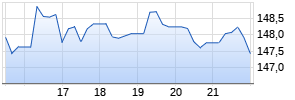
Neurocrine Biosciences Reports First Quarter 2018 Financial Results
PR Newswire
SAN DIEGO, April 30, 2018
SAN DIEGO, April 30, 2018 /PRNewswire/ -- Neurocrine Biosciences, Inc. (NASDAQ: NBIX) today announced its financial results for the first quarter 2018, and provided an update on the launch of INGREZZA® (valbenazine) and its clinical development programs.

"We have had a tremendous start to 2018 with continued strong demand for INGREZZA, positive Phase III uterine fibroids results announced by AbbVie, and now have a well-defined path for a first half 2019 NDA for opicapone. One year into the commercial launch, INGREZZA's positive clinical impact is clear and we will be expanding our sales force by the fourth quarter to help more patients with tardive dyskinesia," said Kevin Gorman, Ph.D., Chief Executive Officer of Neurocrine Biosciences. "In regards to our pipeline, together with AbbVie, we remain very confident in the NDA for elagolix in the treatment of endometriosis-associated pain, with an FDA decision expected in the third quarter of this year. Finally, our clinical team remains focused on executing our CAH and Tourette syndrome programs with important data expected throughout 2018."
First Quarter Financial Results
Neurocrine reported net product sales for INGREZZA of $71.1 million for the first quarter ended March 31, 2018. No similar net product sales were reported for the comparable period of 2017. INGREZZA was made available for commercial distribution on May 1, 2017.
For the first quarter of 2018, the Company reported a net loss of $41.8 million, or $0.47 loss per share, compared to a net loss of $78.3 million, or $0.90 loss per share, for the same period in 2017.
Research and development (R&D) expenses were $48.9 million during the first quarter of 2018 compared to $51.9 million for the first quarter of 2017. The decrease from the prior year is primarily due to a $30 million payment in 2017 to BIAL – Portela & CA, S.A. (BIAL) for the exclusive licensing of opicapone, partially offset by increased R&D program activity spending, an approximately $8 million non-recurring share-based compensation charge, and a $10 million event-based payment to BIAL resulting from the ability to file the opicapone New Drug Application (NDA) based on the existing clinical dataset.
ARIVA.DE Börsen-Geflüster
Weiter abwärts?
| Kurzfristig positionieren in Neurocrine Biosciences | ||
|
ME927K
| Ask: 1,13 | Hebel: 5,89 |
| mit moderatem Hebel |
Zum Produkt
| |

Kurse
 |
Sales, general and administrative (SG&A) expenses increased to $58.6 million for the first quarter of 2018 from $28.1 million for the first quarter of 2017. The increase in SG&A expense is primarily due to the hiring of our sales force and commercialization activities for INGREZZA, which was commercially launched in the second quarter of 2017.
The Company's balance sheet at March 31, 2018 reflected total assets of $806.4 million, including cash, investments and receivables of $784.8 million, compared with total assets at December 31, 2017 of $817.6 million.
Updated 2018 Expense Guidance
Ongoing operating expenses for 2018 are now expected to approximate $395 to $420 million, inclusive of an increase to $58 million of share-based compensation expense, which compares to the prior operating expense guidance of $365 to $395 million. The increase from prior guidance is largely driven by the announced commercial expansion, first quarter 2018 milestone payment to BIAL for opicapone, and increase in share-based compensation.
Pipeline Highlights
INGREZZA (valbenazine) Update
INGREZZA received U.S. Food and Drug Administration (FDA) approval on April 11, 2017, becoming the first medicine approved in the United States for the treatment of adults with tardive dyskinesia.
Valbenazine is being investigated in Tourette syndrome and has been granted Orphan Drug Designation by the FDA for the treatment of pediatric patients with Tourette syndrome. Orphan Drug Designation is granted by the FDA to drugs that are intended to treat rare diseases or conditions in the United States.
In the fourth quarter of 2017, the Company initiated a valbenazine Tourette syndrome study, T-Force GOLD, in pediatric patients. This study is a multicenter, randomized, double-blind, placebo-controlled, parallel-group, Phase IIb study to evaluate the safety, tolerability, efficacy and optimal dose of once-daily valbenazine in up to 120 pediatric patients with moderate to severe Tourette syndrome over 12 weeks of treatment. The primary endpoint of this study is the change from baseline of the Yale Global Tic Severity Scale between placebo and active treatment groups at the end of week 12 with top-line data expected in late 2018.
The Company also recently started a double-blind, placebo-controlled, randomized withdrawal study of valbenazine in pediatric patients with Tourette syndrome, T-Force PLATINUM. This study is designed to evaluate longer term efficacy and safety in patients who initially respond to open-label therapy with optimized doses of valbenazine. Approximately 180 patients will participate in the study. Enrollment is expected to begin during the second quarter of 2018 with top-line data expected in late 2019.
In March 2015, the Company announced that it had entered into an exclusive collaboration and licensing agreement for the development and commercialization of INGREZZA in Japan and other select Asian markets with Mitsubishi Tanabe Pharma Corporation (MTPC). In 2017, MTPC initiated a pivotal trial of INGREZZA in Japan for the treatment of tardive dyskinesia.
Elagolix Update
On October 27, 2017, AbbVie, in collaboration with Neurocrine, announced that the FDA had granted Priority Review to elagolix for the management of endometriosis with associated pain. The FDA grants Priority Review to medicines that it determines have potential to provide significant improvements in the safety and effectiveness of the treatment of a serious disease. Priority Review shortens the FDA review timeframe from ten months from acceptance of the NDA filing to six months. On April 10, 2018, AbbVie announced that late in the elagolix NDA review cycle, it had submitted additional data to the FDA related to the impact of elagolix on liver function. AbbVie was notified by the FDA that the submission of this data met the criteria for a major amendment which resulted in a three-month extension to the NDA review period; moving the PDUFA date into the third quarter of 2018.
During the first quarter of 2018, AbbVie provided positive top-line efficacy data from two Phase III studies in women with uterine fibroids. The ELARIS UF-I and UF-II studies of elagolix met all primary and ranked secondary endpoints at month six. These replicate Phase III studies were randomized, parallel, double-blind, placebo-controlled clinical trials evaluating elagolix alone or in combination with add-back therapy in women with heavy uterine bleeding associated with uterine fibroids. The studies enrolled approximately 400 subjects each for an initial six-month placebo-controlled dosing period. At the end of the six months of placebo-controlled evaluation, subjects were eligible to enter an additional six-month safety extension study. The primary efficacy endpoint of the study was an assessment of the change in menstrual blood loss utilizing the alkaline hematin method comparing baseline to month six. Additional secondary efficacy endpoints were evaluated including the change in fibroid volume and hemoglobin. Bone mineral density was assessed via dual-energy x-ray absorptiometry (DEXA) scan at baseline, at the conclusion of dosing, and at six months post-dosing. Results from these studies will form the basis for an anticipated 2019 supplemental NDA submission to the FDA for the approval of elagolix in the treatment of uterine fibroids.
Opicapone Update
In February 2017, the Company entered into an exclusive licensing agreement with BIAL for the development and commercialization of opicapone in the United States and Canada. Opicapone is a once-daily, peripherally-acting, highly-selective catechol-o-methyltransferase inhibitor being developed as an adjunct therapy to preparations of levodopa/DOPA decarboxylase inhibitors for adult patients with Parkinson's disease and motor fluctuations. The Company met with the FDA in January and determined no additional Phase III trials were necessary to form an NDA submission. The Company is in the process of preparing for an NDA submission which it anticipates will occur during the first half of 2019.
Congenital Adrenal Hyperplasia (CAH) Program (NBI-74788) Update
In the second quarter of 2017, the Company successfully completed the Phase I, IND-opening study of NBI-74788 in healthy volunteer subjects. The study was a randomized, open-label, two-period crossover study to evaluate the pharmacokinetics (PK), the effect of food on PK, and the safety of NBI-74788 in a total of 16 healthy adults.
The Company began recruitment for a Phase II, proof-of-concept study examining the PK, pharmacodynamics, and safety of NBI-74788 in adult males and females with classic, 21-hydroxylase deficiency CAH in November of 2017. The study will evaluate the relationship between NBI-74788 exposures and specific steroid hormone levels in these subjects. Data are expected to be available in the summer of 2018.
Conference Call and Webcast Today at 5:00 PM Eastern Time
Neurocrine will hold a live conference call and webcast today at 5:00 p.m. Eastern Time (2:00 p.m. Pacific Time). Participants can access the live conference call by dialing 877-876-9176 (US) or 785-424-1667 (International) using the conference ID: NBIX. The call can also be accessed via the webcast through the Company's website at http://www.neurocrine.com.
About INGREZZA® (valbenazine) Capsules
INGREZZA, a selective vesicular monoamine transporter 2 (VMAT2) inhibitor, is the first FDA approved product indicated for the treatment of adults with tardive dyskinesia, a condition associated with uncontrollable, abnormal and repetitive movements of the trunk, extremities and/or face.
INGREZZA is thought to work by reducing the amount of dopamine released in a region of the brain that controls movement and motor function, helping to regulate nerve signaling in adults with tardive dyskinesia. VMAT2 is a protein in the brain that packages neurotransmitters, such as dopamine, for transport and release in presynaptic neurons. INGREZZA, developed in Neurocrine's laboratories, is novel in that it selectively inhibits VMAT2 with no appreciable binding affinity for VMAT1, dopaminergic (including D2), serotonergic, adrenergic, histaminergic, or muscarinic receptors. Additionally, INGREZZA can be taken for the treatment of tardive dyskinesia as one capsule, once-daily, together with psychiatric medications such as antipsychotics or antidepressants.
Important Safety Information
Warnings & Precautions
Somnolence
INGREZZA can cause somnolence. Patients should not perform activities requiring mental alertness such as operating a motor vehicle or operating hazardous machinery until they know how they will be affected by INGREZZA.
QT Prolongation
INGREZZA may prolong the QT interval, although the degree of QT prolongation is not clinically significant at concentrations expected with recommended dosing. INGREZZA should be avoided in patients with congenital long QT syndrome or with arrhythmias associated with a prolonged QT interval. For patients at increased risk of a prolonged QT interval, assess the QT interval before increasing the dosage.
Adverse Reactions
The most common adverse reaction (≥5% and twice the rate of placebo) is somnolence. Other adverse reactions (≥2% and >placebo) include: anticholinergic effects, balance disorders/falls, headache, akathisia, vomiting, nausea, and arthralgia.
You are encouraged to report negative side effects of prescription drugs to the FDA. Visit MedWatch at www.fda.gov/medwatch or call 1-800-FDA-1088.
Please see INGREZZA full Prescribing Information at www.INGREZZAHCP.com.
About Neurocrine Biosciences, Inc.
Neurocrine Biosciences is a San Diego based biotechnology company focused on neurological and endocrine related disorders. The Company markets INGREZZA® (valbenazine) capsules in the United States for the treatment of adults with tardive dyskinesia. INGREZZA is a novel, selective vesicular monoamine transporter 2 (VMAT2) inhibitor, and is the first FDA approved product indicated for the treatment of adults with tardive dyskinesia. The Company's three late-stage clinical programs are: elagolix, a gonadotropin-releasing hormone antagonist for women's health that is partnered with AbbVie Inc.; opicapone, a novel, once-daily, peripherally-acting, highly-selective catechol-o-methyltransferase inhibitor under investigation as adjunct therapy to levodopa in Parkinson's patients; and INGREZZA, a novel, once-daily, selective VMAT2 inhibitor under investigation for the treatment of Tourette syndrome.
Neurocrine Biosciences, Inc. news releases are available through the Company's website via the internet at http://www.neurocrine.com.
Forward-Looking Statements
In addition to historical facts, this press release contains forward-looking statements that involve a number of risks and uncertainties. These statements include, but are not limited to, statements related to the benefits to be derived from Neurocrine's products and product candidates, including INGREZZA; the value INGREZZA and our product candidates may bring to patients; the continued success of the launch of INGREZZA; and the timing of completion of our clinical and other development activities and those of our collaboration partners. Among the factors that could cause actual results to differ materially from those indicated in the forward-looking statements are: the Company's future financial and operating performance; risks and uncertainties associated with the commercialization of INGREZZA, including the likelihood of continued revenue and prescription growth of INGREZZA; risks or uncertainties related to the development of the Company's product candidates; risks and uncertainties relating to competitive products and technological changes that may limit demand for INGREZZA or a product candidate; risks associated with the Company's dependence on third parties for development and manufacturing activities related to INGREZZA and the Company's product candidates, and the ability of the Company to manage these third parties; risks that the FDA or other regulatory authorities may make adverse decisions regarding INGREZZA or the Company's product candidates; risks associated with the Company's dependence on AbbVie for the development and commercialization of elagolix; risks that clinical development activities may not be completed on time or at all; risks that clinical development activities may be delayed for regulatory or other reasons, may not be successful or replicate previous clinical trial results, may fail to demonstrate that our product candidates are safe and effective, or may not be predictive of real-world results or of results in subsequent clinical trials; risks that the benefits of the agreements with BIAL and Mitsubishi Tanabe may never be realized; risks associated with the Company's dependence on BIAL for tech transfer, development and manufacturing activities related to opicapone; risks associated with the Company's dependence on Mitsubishi Tanabe for the development and commercialization of valbenazine in Japan and other Asian countries; risks that INGREZZA and/or our product candidates may be precluded from commercialization by the proprietary or regulatory rights of third parties, or have unintended side effects, adverse reactions or incidents of misuse; and other risks described in the Company's periodic reports filed with the Securities and Exchange Commission, including without limitation the Company's annual report on Form 10-K for the year ended December 31, 2017. Neurocrine disclaims any obligation to update the statements contained in this press release after the date hereof.
| NEUROCRINE BIOSCIENCES, INC. | |||
| CONDENSED CONSOLIDATED STATEMENTS OF OPERATIONS | |||
| (in thousands, except per share data) | |||
| (unaudited) | |||
| | | | |
| | | | |
| | Three Months Ended | ||
| | 2018 | | 2017 |
| Revenues: | | | |
| Product sales, net | $ 71,086 | | $ - |
| | | | |
| Total revenues | 71,086 | | - |
| Operating expenses: | | | |
| Cost of product sales | 950 | | - |
| Research and development | 48,947 | | 51,882 |
| Sales, general and administrative | 58,636 | | 28,050 |
| | | | |
| Total operating expenses | 108,533 | | 79,932 |
| | | | |
| Loss from operations | (37,447) | | (79,932) |
| Other (expense) income: | | | |
| Deferred gain on real estate | 201 | | 879 |
| Interest expense | (7,504) | | - |
| Investment income, net | 2,932 | | 727 |
| | | | |
| Total other (expense) income | (4,371) | | 1,606 |
| | | | |
| Net Loss | $ (41,818) | | $ (78,326) |
| | | | |
| Net loss per common share: | | | |
| Basic and diluted | $ (0.47) | | $ (0.90) |
| | | | |
| Shares used in the calculation of net loss per common share: | | | |
| Basic and diluted | 89,526 | | 87,283 |
| | | | |
| | | | |
| NEUROCRINE BIOSCIENCES, INC. | | |||||||||||
| Condensed Consolidated Balance Sheets | | |||||||||||
| (in thousands) | | |||||||||||
| | | | (unaudited) Werbung Mehr Nachrichten zur Neurocrine Biosciences Aktie kostenlos abonnieren
E-Mail-Adresse
Bitte überprüfe deine die E-Mail-Adresse.
Benachrichtigungen von ARIVA.DE (Mit der Bestellung akzeptierst du die Datenschutzhinweise) -1  Vielen Dank, dass du dich für unseren Newsletter angemeldet hast. Du erhältst in Kürze eine E-Mail mit einem Aktivierungslink. Hinweis: ARIVA.DE veröffentlicht in dieser Rubrik Analysen, Kolumnen und Nachrichten aus verschiedenen Quellen. Die ARIVA.DE AG ist nicht verantwortlich für Inhalte, die erkennbar von Dritten in den „News“-Bereich dieser Webseite eingestellt worden sind, und macht sich diese nicht zu Eigen. Diese Inhalte sind insbesondere durch eine entsprechende „von“-Kennzeichnung unterhalb der Artikelüberschrift und/oder durch den Link „Um den vollständigen Artikel zu lesen, klicken Sie bitte hier.“ erkennbar; verantwortlich für diese Inhalte ist allein der genannte Dritte. Andere Nutzer interessierten sich auch für folgende News | |||||||||



